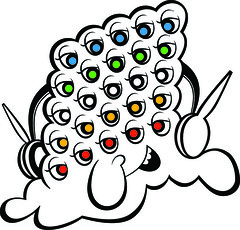A recent Slate Magazine Article aptly entitled "The Oldest Profession" was an interesting perspective on the reasoning for many architects to practice late into their years.
Using Philip Johnson, I.M. Pei, Frank Lloyd Wright, Mies, van der Rohe, Corbusier and Gehry as examples to explain the amount of learning and experience necessary to become proficient in such a detailed profession as architecture Slate makes the argument that once you get finally get good at something there is no reason to quit.
Probably an important read for impatient youngsters wondering when they are going to get the chance to make their mark on the world.
Hint, probably way in the future but it takes hard work to get there.
Post title taken from Pavement's "The Hexx" which contains the fantastic line:
"Architecture students are like virgins
with an itch they cannot scratch,
Never build a building till you're 50
what kind of life is that?"
Saturday, September 13, 2008
Friday, September 12, 2008
Tremont Artwalk - September 12th

Tremont Art Walk
Friday, September 12th, 2008
6-10pm
Tremont neighborhood of Cleveland, Ohio
Image supplied:
Chitower
On display at Studio 11 a collection of photographs captured by Andy Gabriel of Cleveland
Climate Change vs. Design - heat island effect

At the recent Califiornia Climate Change Conference
One of the interesting topics covered was the possibility of utilizing white roof technology in urban environments to offset heat island effect. The premise of the main argument is "Increasing World-wide Urban Albedos to Offest CO2". Roughly translated implementation of higher albedo surfaces (such as pavement and roofs) on a large scale in urban environments directly cool the globe by reflecting solar radiation (in a similar manner to polar ice). In this manner higher albedo surfaces can offset a specific CO2 emission (10 meters squared of white roof offsets 1 ton CO2) by directly cooling the planet's surface area independent of CO2 emissions.
Besides decreasing the operational costs of specific buildings and cooling urban environments increasing comfort the proposal to offset carbon emissions via high albedo requirements for urban environments on a grand scale could help alleviate the burden of greenhouse gases until technology can catch up with lower (or hopefully non) emission solutions.
Happily the cost of white roofing has dropped dramatically to be cost effective for new and replacement construction however it may fall to municipalities to create and enforce requirements for higher albedo pavement (parking and sidewalks).
Global Cooling: Increasing World-wide Urban Albedos to Offset CO2 .pdf
Wednesday, September 10, 2008
American Express Members Project down to 25 selections.
The goal is to narrow down the top 5 projects to move into the next phase of the awarding. You can see the placement of this project on the link above.
Architecture for Humanity Link
Previously mentioned here...
Sunday, September 07, 2008
The air up there

While at the Burning River Fest a while back I had noticed a booth where the discussion was centered around airborne contaminants. I queried whether the county had real time tracking of particulate matter from specific locations as I am typically interested in real time results from the surrounding region. Part of it is due to my desire to quantify site specificity as a design precedence as well as my necessity to know what is going on everywhere.
Currently the county does not have real time mapping or data stream, at least according to the booth I inquired at (which may have been the Environmental Health Watch booth, I wrote it down but misplaced my notes).
I had read about an "installation" during last years CONFLUX festival whereas a person pushing a cart that monitored CO2 emissions walked a main path adjacent to a road way and demonstrated the amount of pollution being emitted, and consequently inhaled, by festival visitors. I found it an interesting way to connect directly, via real time measurements and results, to the general public in an educational manner that tied together how our everyday choices and interactions with our environment affect our health.
Whereas particulate matter in Cuyahoga County is directly connected to respiratory illnesses (or in case of our current time of year, allergies), I would think that wind data and pollution data would be interesting to study. Granted it may seem difficult to have such data constantly at our fingertips, but currently groups are working with that very goal in mind.
The Black Cloud Citizen Scientist League has developed "Pufftron" sensors to measure air quality, temperature and noise is specific Los Angeles and Bary Area areas.
Currently there are 5 sites under the scrutiny of the "Pufftron" data loggers which have data streams visible online. This real time data streaming allows anyone to instantly view and hopefully understand external events and their affect upon quality of life, a major concern of a good design professional. Recent growth in environmental awareness and passive design strategies should inherently justify the value of studies such as this which would hopefully result in techniques and technologies that either limit environmental pollutants or design strategies for dwellings and structures to combat, collect/deflect or avoid such contaminants if deemed desirable.
resources:
Scorecard: Pollution Report Card - Cuyahoga County
Subscribe to:
Comments (Atom)
